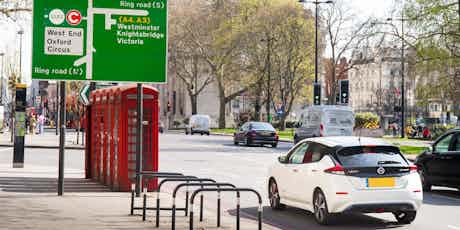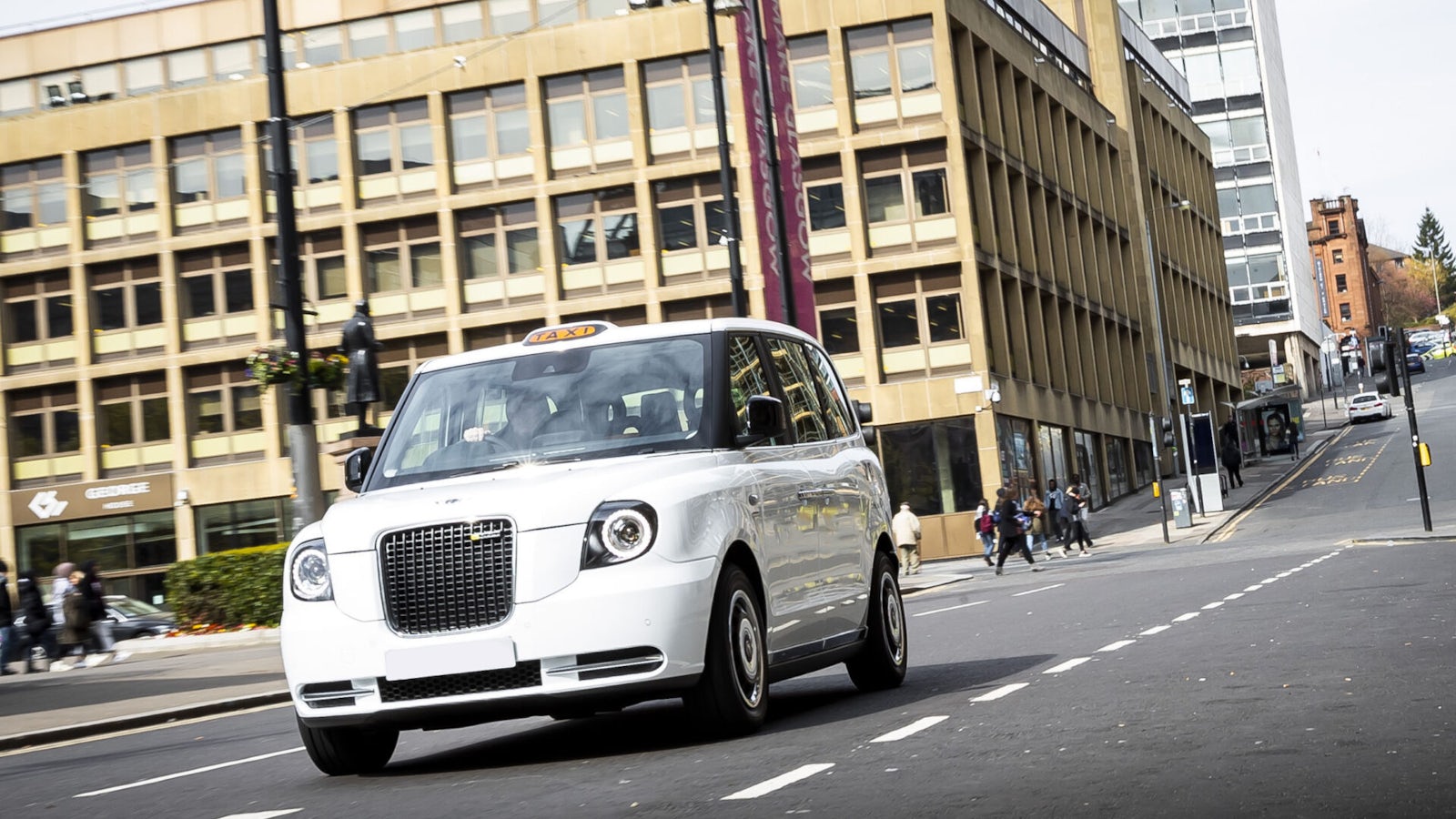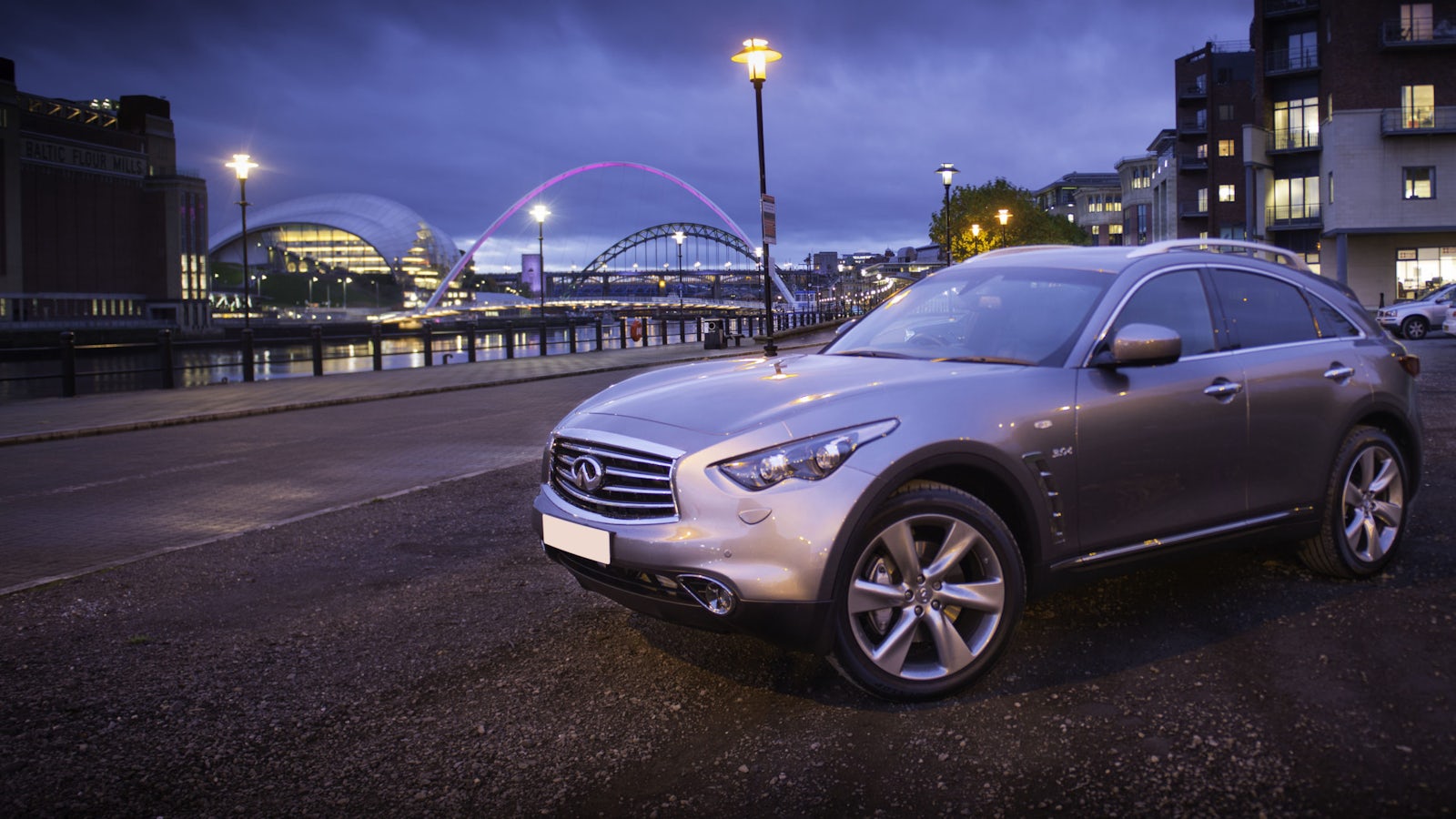Clean Air Zones (CAZ) & Low Emissions Zones (LEZ) in the UK
July 08, 2024 by Jamie Edkins

Clean Air Zones and Low Emissions Zones are being introduced across the UK. What are they and how will they affect drivers? Read on to find out.
If you spend a lot of time driving around large cities, chances are you’ve come across a Clean Air Zone (CAZ) at some point. Clean air zones are being implemented across the country to reduce pollution in built up areas. Read on to find out more.
What are clean air zones and low emission zones?
A Low Emissions Zone, often referred to as a LEZ or sometimes a CAZ (Clean Air Zone – the terms are used interchangeably), is an inner-city area that drivers of more polluting vehicles must pay to drive through. The aim is to encourage drivers to use newer, less polluting vehicles or make the switch to public transport.
The most well-known low-emission zones are the London ULEZ (Ultra-Low Emission Zone) and LEZ (Low Emission Zone – this one’s for trucks and HGVs), although more UK cities are introducing their own clean-air zones so if you’re heading for a big city, you’ll have to check if you’ll encounter one – or risk a penalty fine. Here’s everything you need to know.
For specific advice on LEZs in Scotland read: Low Emission Zones in Scotland
Why have clean air zones and low emission zones been introduced?
We’ve learnt a lot about air pollution in the last 20 years or so, with growing evidence indicating the exhaust fumes from older diesel cars can be particularly harmful to human health. Nitrogen oxides and particulate matter – the latter essentially being microscopic pieces of soot – are linked to everything from heart disease to asthma, and are prevalent in untreated diesel exhaust fumes. When heavy traffic combines with dense populations – such as in towns and cities – these emissions build up in the air and are breathed in by people.
Diesel cars made since around 2016 must, by law, have diesel particulate filters that trap the tiny pieces of soot. Selective catalytic reduction (SCR), which is more commonly known as AdBlue, is another way a lot of manufacturers reduce diesel emissions. It sees a urea-based liquid squirted into a diesel car’s exhaust gases, converting nitrogen oxides into water and nitrogen. A large percentage of diesel cars have to have SCR in order to meet Euro 6 emission standards, which is why Euro emissions standards are used to determine which cars can enter the CAZ and which ones can’t.
Petrol cars emit more carbon dioxide than diesels, but little-to-no particulate matter and much less nitrogen oxide – hence why earlier, Euro 4 standards (introduced over 2005/6) are used as the barrier to entry for petrol cars driving into LEZs and CAZ.
For these reasons, authorities have introduced these Clean Air Zones, with Transport for London launching the ULEZ (which is an example of a CAZ) in 2017, and central government mandating certain cities to bring in similar zones at later dates.
In addition to this, Highways England has also started to introduce temporary 60mph speed limits on several UK motorways in an attempt to reduce levels of Nitrogen Dioxide (NO2) in the surrounding areas, often near large cities.
Where are clean air zones and low emission zones located in the UK?
- London
- Birmingham
- Bristol
- Oxford
- Glasgow
- Bath
- Bradford
- Portsmouth
- Manchester
- Aberdeen
- Dundee
- Edinburgh
- Newcastle
- Sheffield
London
London has two zones designed to restrict the use of more polluting vehicles. The Ultra-Low Emissions Zone was expanded on 29 August 2023 to cover almost all areas inside the M25. including Heathrow airport.
Vehicles that do not meet the ULEZ requirements are required to pay a charge. This is £12.50 for cars, motorcycles and vans, and £100 for heavier vehicles, including lorries over 3.5 tonnes, plus buses and coaches over 5 tonnes. Congestion Charge fees continue to apply to all vehicles, however. Petrol cars not meeting Euro 4 standards and diesels not meeting Euro 6 rules must pay the fee if they enter the ULEZ.

Our handy ULEZ checker shows you the exact boundaries of both the LEZ and ULEZ in London, and tells you whether your vehicle is ULEZ-compliant or not.
The second London emission zone is the Low Emission Zone, or LEZ. This covers most of greater London, but it only applies to HGVs, buses and coaches – not cars.
Most other emission zones in the UK do not apply to private cars.
Birmingham

Birmingham’s CAZ became operational in 2021 and covers all roads within the Middleway Ring Road. It works under similar rules to London’s ULEZ, operating 24 hours a day and seeing more polluting cars (pre Euro 4 petrols and pre Euro 6 diesels) charged £8 to drive in the zone, while non-compliant buses and lorries pay £50.
Bristol
Bristol’s CAZ came into force on 28 November 2022, and sees drivers of more polluting cars charged if they enter a portion of the city centre. As with London’s ULEZ, it affects pre-Euro 4 petrol cars and pre-Euro 6 diesels, which have to pay £9 to enter the zone. Non-compliant taxis and light vans face the same charge, while HGVs and buses pay £100.
Oxford
Oxford’s Zero Emission Zone is very small, covering nine streets in the city centre, with all private cars other than electric ones having to pay £2 to £10 to enter the zone. More polluting cars (EG non Euro 6 diesels) pay the higher charges.
Glasgow

Glasgow city centre was the first area in Scotland to have a low emission zone introduced, and came into effect on December 31 2018 overing one square mile inside the M8 motorway. Two phases form part of the plans, with the first having covered local buses. The second sees all vehicles needing to meet Euro 4 and 6 (for petrol and diesel cars respectively) emissions standards, but unlike other emission zones, drivers of non-compliant vehicles can’t pay to enter in the zone, with a £60 penalty for breaching the rules, and this penalty doubling until it reaches a £480 cap, regardless of whether the initial penalty is paid or not. Glasgow’s Low Emission Zone came into force on 1 June 2023.
Bath
Bath launched its Clean Air Zone in March 2021. It doesn’t affect private cars and motorbikes, so you shouldn’t have to pay a fee if you’re driving around in your own car, though business-use vehicles such as taxis and HGVs have to pay a fee if they don’t meet certain emissions standards.
Bradford
Bradford’s Clean Air Zone doesn’t apply to private cars, only taxis, lorries and other commercial vehicles. Taxis pay £7 to enter the zone, with HGVs and buses paying £50.
Portsmouth
Portsmouth’s CAZ covers a small area of Portsea island. Taxis that don’t meet the respective Euro standards must pay £10 a day to enter the zone, with HGVs and buses paying £50. Private cars are not affected.
Manchester
A proposal was made in 2022 for a clean air zone across Greater Manchester, however Mayor Andy Burnham has since scrapped this plan in favour of an investment-based approach instead.

Burnham claims that investing in zero-emission buses and taxis, as well as traffic management systems and public transport, is a more effective way to lower emissions in the city. You can read more about these proposals here.
Aberdeen
Aberdeen introduced a Low Emissions Zone in May 2022, though enforcement only started at the end of May 2024. Pre-Euro 6 diesel and pre-Euro 4 petrol cars are prohibited from entering the zone.
Dundee
Similarly to Aberdeen, Dundee City Council’s LEZ was introduced in 2022, but a two-year grace period meant it wasn’t enforced until May 2024. It follows the same vehicle rules as Aberdeen’s LEZ.
Edinburgh
Edinburgh’s LEZ follows the same rules as the three Scottish cities above, with enforcement beginning in June 2024.
Newcastle

Newcastle City Council introduced its CAZ in October 2022, and began to charge drivers from January 2023 – though it only applies to older taxis, vans, buses, coaches and HGVs – private cars are not affected.
Sheffield
Like other CAZ, Sheffield’s Clean Air Zone won’t affect private vehicles for the time being — though older taxis, vans and large vehicles will be subject to a charge for entering the zone, which will begin operating in June 2023. LGVs and taxis will have to pay £10 a day, with coaches, buses and HGVs subject to a £50 fee.
What vehicles are exempt from LEZ and CAZ charges?
Though many of the UK’s zones aren’t yet impacting private cars, it’s possible they will in the future.
Almost all CAZ, LEZ and ULEZ in the UK that charge private cars use Euro Emission standards as the basis for whether or not drivers have to pay. Euro standards are tightened up periodically (hence why we’re now on the sixth iteration) and they were never intended to be used in the manner they are with emission zones, instead being emission-based limits new cars have to meet before they can be sold in Europe.
Older diesel cars are relatively polluting (though systems such as AdBlue mean modern ones are on a par with petrols), which is why the rules are tougher for diesels.
As a rule of thumb, expect all emission zones that affect private cars to charge pre-Euro 6 diesels and pre Euro 4 petrols.
Euro standards are introduced gradually, first applying to newly introduced models launched to the market, before applying to all new cars sold in showrooms.
As a result, it’s tricky to give precise dates for when cars are likely to meet these standards, but as a general rule if a diesel car was bought new in late 2015 and onwards it should be Euro 6 compliant, and thus exempt from emission-zone charges. For petrol cars the date is more like 2006 and onwards. In both instances, it’s possible both later and earlier cars will attract or be exempt from the charges (Euro standards were never meant to be used in this way for a reason).
How much does it cost to enter a LEZ or CAZ?
Between nothing and £300, depending on the zone and your vehicle.
That £300 charge is for HGVs not meeting standards and driving into London’s LEZ, with most charges being much less for cars.
The table below outlines the current zones that apply to private car drivers.
| Zone | Charges apply to | Fee |
| London ULEZ | Pre Euro 4 petrols, pre Euro 6 diesels | £12.50 |
| Birmingham CAZ | Pre Euro 4 petrols, pre Euro 6 diesels | £8 |
| Bristol CAZ | Pre Euro 4 petrols, pre Euro 6 diesels | £9 |
| Oxford ZEZ | All cars but electric/hydrogen ones | £2-£10 |
If in doubt, you can use our clean air zone checker to see if your car will face any charges.
Clean air zones and low emission zones FAQs
How do I pay the LEZ or CAZ charge?
Each LEZ has its own payment system, but it’s pretty simple to pay to enter the zones. The ULEZ, for instance, is most easily paid online via TfL’s website, although you can download the TfL app, or call a telephone helpline, while an auto-pay account (which will automatically detect your vehicle has entered the zone and take direct payment from your bank account) is worth considering if you regularly need to drive a non-compliant vehicle into the ULEZ. Payment for the Birmingham and Bristol CAZ are best made through the Government’s online portal.
Do be warned that there are a number of scam websites that look like official payment channels, sometimes even copying the distinctive black-and-white colour schemes of the Government’s official websites. These scams will purport to take payment from you (sometimes with this payment being higher than the official charge), but not actually pay the ULEZ charge, leaving you scammed out of the payment amount, as well as receiving a fine from TfL for not paying the fee to enter the zone. To avoid such scams, make sure you only use official payment channels by looking closely at the web address in the URL bar of your internet browser. TfL and the Government pages have ‘gov.uk’ suffixes in their site addresses.
Can I claim VAT on the LEZ or CAZ charge?
No, these fees are non-business statutory levies, so are not within the scope of VAT. If you’re self-employed, LEZ and CAZ charges should be tax deductible if you need to pay them for reasons related to normal business travelling expenses, though.
How do I know if I’ve entered a LEZ or CAZ?
LEZs and CAZs are generally well signposted both in advance of their commencement (EG a sign may read ‘Ultra Low Emission Zone, 3 miles ahead’) and as you enter them. If you fail to spot these signs (they’re also sometimes indicated by road markings) then the first you know of the fact you’ve entered a zone might be when you receive a penalty for not paying the charge. The onus, rightly or wrongly, falls on drivers to know where these zones are, if their car is compliant, and if they have entered them.
What happens if I don’t pay the LEZ or CAZ charge?
You can pay CAZ and LEZ charges generally one day in advance, or three days in the past (EG if you entered the ULEZ on a Saturday, you have until Tuesday to pay it). Fail to do so and you will receive a penalty charge notice (PCN) from TfL, which stands at £180, reduced to £90 if paid within 14 days. Birmingham’s CAZ brings a £120 penalty for failure to pay, again, reduced by 50% if paid within 14 days.
Cars Change? Carwow!
Looking for a new set of wheels? With Carwow you can sell your car quickly and for a fair price – as well as find great offers on your next one. Whether you’re looking to buy a car brand new, are after something used or you want to explore car leasing options, Carwow is your one stop shop for new car deals.















